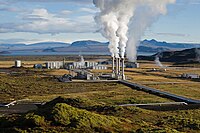
Photo from wikipedia
Deep geothermal energy (DGE) represents an opportunity for a sustainable and carbon-free energy supply. One of the main concerns of DGE is induced seismicity that may produce damaging earthquakes, challenging… Click to show full abstract
Deep geothermal energy (DGE) represents an opportunity for a sustainable and carbon-free energy supply. One of the main concerns of DGE is induced seismicity that may produce damaging earthquakes, challenging its widespread exploitation. It is widely believed that the seismicity risk can be controlled by using doublet systems circulating water to minimize the injection-induced pressure changes. However, cold water reinjection may also give rise to thermal stresses within and beyond the cooled region, whose potential impacts on fault reactivation are less well understood. Here, we investigate by coupled thermo-hydro-mechanical modeling the processes that may lead to fault reactivation in a hot sedimentary aquifer (HSA) in which water is circulated through a doublet. We show that thermal stresses are transmitted much ahead of the cooled region and are likely to destabilize faults located far away from the doublet. Meanwhile, the fault permeability mainly controls the fault reactivation timing, which entails the importance of employing appropriate characterization methods. This investigation is crucial for understanding the mechanisms controlling induced seismicity associated with DGE in a HSA and allows the success of future DGE projects.
Journal Title: Scientific Reports
Year Published: 2022
Link to full text (if available)
Share on Social Media: Sign Up to like & get
recommendations!